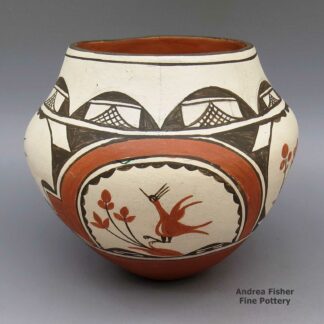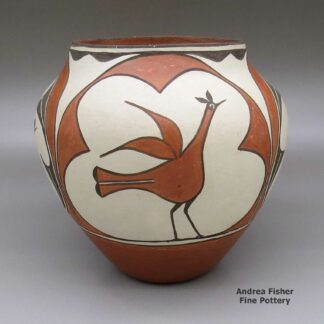Zia
A Short History of Zia Pueblo

Zia Pueblo is situated in the Jemez Mountains with Jemez Pueblo to the north and Santa Ana Pueblo to the south. Despite its picture postcard setting, Zia's history for the last four hundred years has been difficult.
Antonio de Espejo led a small troop of Spanish explorers up the Jemez River and discovered Zia Pueblo in 1583. Espejo estimated there were about 4,000 inhabitants in a city of house blocks up to three and four stories high with five major plazas and many smaller ones. "The people are clean. The women wear a blanket over their shoulders tied with a sash at their waist - their hair cut in front, and the rest plaited so that it forms two braids, and above a blanket of turkey feathers," is how Espejo's scribe recorded it.
The people of Zia participated in the Pueblo Revolt of 1680 and when Spanish troops returned in 1682 and 1687, the Zias were able to repulse them. When more Spanish troops returned in 1688 they were finally successful in conquering the Zias. The Spanish killed many people, burned the pueblo and took many slaves back to Mexico with them.
When Don Diego de Vargas returned to northern Nuevo Mexico in 1692, the Zias sued for peace and accepted the rule of Spain almost immediately. In the revolt of 1696 the Zia, Santa Ana and San Felipe remained loyal to the Spaniards. In another revolt in 1728-9, Zia joined with Jemez, Santa Ana and Cochiti against the Spaniards and when things turned against them, they all fled to various mountain refuges while the Spaniards again burned everything they left behind.
The new Spanish government did little to protect the pueblos from the raids of nomadic Ute, Apache, Comanche and Navajo warriors. Nor did the government of Mexico after it declared independence from Spain in 1820 nor did the government of the United States after it acquired Zia in 1848. Zia fortunes slid in many ways and by the 1890s the tribe was down to just 98 members.
Today, the Pueblo of Zia numbers about 800 people, many of whom are active artists producing everything from pottery to jewelry to baskets to paintings, sculptures and wood carvings.

For more info:
Pueblos of the Rio Grande, Daniel Gibson, ISBN-13:978-1-887896-26-9, Rio Nuevo Publishers, 2001
Photo courtesy of Jared Tarbell, Creative Commons Attribution 2.0 Generic License
About the Pottery of Zia Pueblo
The potters of Zia Pueblo have been known for making large, sturdy utilitarian pottery for more than 500 years. Their landscape yields significant deposits of sandy clay to work with. However, that sandy clay is too coarse to be polished to a high sheen like San Ildefonso and Santa Clara clay. Zia clay also doesn't carve or etch well. Most Zia pottery is made with thick walls covered with an off-white slip to provide a background canvas for their traditional black and red designs.
The Zias use a limited design vocabulary, consisting mostly of birds (the roadrunner in particular), yucca cactus and flowers, and bold geometrics. The sun symbol on the New Mexico state flag is a design taken from the Zia people.
In the old days, the Zias traded pottery for food, often with Santa Ana and Jemez. Trade with the Jemez ramped up after the Pueblo Revolt of 1680. The Jemez continued resisting the Spanish for years and the Spanish made it hard for the Jemez to even feed themselves in return. The Spanish also made it hard for the pueblos to trade with each other but trade between Santa Ana and Zia was allowed. That's why today's Santa Ana pottery tradition is filled with Zia-sourced designs.
Around 1900 about 25 Zia women were producing all the pottery the people of Zia needed. Due to the toll of European diseases and the general economic conditions of the time, Zia Pueblo was down to about 120 residents. Then the weather changed and growing food got harder. That's when the Zias began trading more pottery to the Santa Anas for food. That imbalance soon virtually ended pottery making at Santa Ana as it increased production at Zia.
There are more than 600 Zias now living on their pueblo. Their economy has improved as the tribe made a shift out of farming and into cattle and sheep. Still, they are in a very dry area well off the beaten path. And there are only a few people still making pottery in the pueblo.
The most prolific Zia potter these days is probably Ruby Panana and she lives at Jemez Pueblo. Marcellus and Elizabeth Medina are also making pottery at Zia. He is the son of Sofia Medina and Elizabeth is a Toya family member who married and moved in from Jemez.
Our Info Sources
Southern Pueblo Pottery, 2000 Artist Biographies, by Gregory Schaaf, © 2002, Center for Indigenous Arts & Studies.
Some information may have been gleaned from Pottery by American Indian Women: Legacy of Generations, by Susan Peterson, © 1997, Abbeville Press.
Some info may be sourced from Fourteen Families in Pueblo Pottery, by Rick Dillingham, © 1994, University of New Mexico Press, Albuquerque.
Other info may be derived from old newspaper and magazine clippings, personal contacts with the potter and/or family members, and through interminable searches of the Internet and cross-examination of any results returned.
Data is also checked against the Heard Museum's Native American Artists Resource Collection Online.
If you have any corrections or additional info for us to consider, please send it to: info@andreafisherpottery.com.
Showing all 9 results
-

Elizabeth Medina, cjza3c222, Jar with roadrunner and geometric design
$495.00 Add to cart -

Gloria Gachupin, nuza2m069, Polychrome jar with roadrunner, flower and geometric design
$325.00 Add to cart -

Lois Medina, zzza2l413, Polychrome lidded jar
$1,100.00 Add to cart -

Ruby Panana, zzza3b573, Jar with 3-panel Zia design
$1,200.00 Add to cart -

Seferina Bell, zzza2m500, Polychrome jar with a road runner, checkerboard, and geometric design
$995.00 Add to cart -

Sofia Medina, rsza3a067, Small polychrome jar with a roadrunner and geometric design
$275.00 Add to cart -

Theodora Galvan, rsza3a066, Bowl with a roadrunner and geometric design
$195.00 Add to cart -

Unknown Zia Potter, fbza2m150, Large polychrome jar with roadrunner and geometric design
$9,200.00 Add to cart -

Unknown Zia Potter, zzza2m556, Polychrome jar with a roadrunner and geometric design
$1,300.00 Add to cart
Showing all 9 results